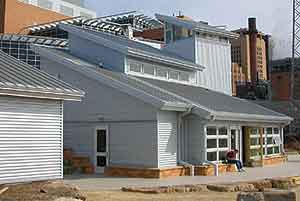Architects' Widening View of Windows: Technical Advances Elevate the Role of Fenestration
Of interest were innovative schemes for day lighting, solar heating and shading in buildings, natural ventilation, and active energy-generating systems such as photovoltaics. Percolation of these design theories into the construction industry, however, proved an ambitious task. When energy prices evened out, smooth skinned glass and steel boxes without operable windows or external sunshades and endless housing tracts developed without regard to site and climate once again became economical and passive solar solutions were nearly abandoned. Only now, with renewed emphasis on sustainable architecture are some of these theories once again seeing the light of day. Yet, the seeds of a different design method were planted. Even the federal government got involved, and in the 1980s promoted the Building Energy Performance Standards, which promoted a performance-based evaluation of a building's design rather than a prescriptive basis.
|
|
At the same time, manufacturers of building components remained concerned with environmental issues, anticipating further world energy resource complications in the future. Window manufacturers offered product solutions. "Thirty years ago, windows were the weakest link in the wall or in the building in terms of thermal energy," says Steve Selkowitz, of Lawrence Berkeley Laboratories, a government agency that has long studied energy use in buildings. "The idea was don't use them or make them as small as possible."
Advances came quickly - single-glazed; double-glazed; triple-glazed; gas-filled insulating glass; quantified heat gain and loss, through conduction as well as infiltration and solar heat gain, using advanced modeling of building performance.
"Now," Selkowitz says, "windows compete with insulated walls in terms of reducing heat and cooling loads."
High performance today is dependent on the entire window assembly, not just the glazing. Since frame and sash materials account for 10 to 30 percent of the total window area, materials have a significant effect on overall performance. Window frames have evolved dramatically from the lead strips that held panes in primitive wood frames. Now they are generally made of wood, vinyl, aluminum, and composites. Materials are now being combined to increase weathering capability, improve structural performance, and reduce maintenance. The material choice has significant performance implications as well as a dramatic impact on the fenestration aesthetic.
A lot of guesswork has been removed from window design and specification in areas of the country vulnerable to extreme forces of nature. Coastal states have been hammered in recent years by more extensive and severe damage from hurricanes and tropical storms, prompting local governments and insurance companies to require protection in the form of shutters, screens, or impact-resistant glazing and frames. After Hurricane Andrew pounded Southern Florida in 1992, the state implemented stringent codes, requiring many new homes within varying proximity to the coast to have impact-resistant window systems. In response, manufacturers have developed a broad portfolio of products with impact-resistant laminated glazing and components to withstand higher design pressures. Social and cultural security concerns also demand sensitive design solutions to physical security requirements. Manufacturers are responding with window systems to withstand varying levels of physical force.
At the same time, window design aesthetics remain a critical part of the package. "The windows are not an eyesore," says Steven Winter, architect and director of Steven Winter Associates. "Not a neces-sary evil. They are something we use for their technical performance as well as their psychological and visual performance…." In fact, Winter refers to decorative windows as "jewelry."
Can the window industry go further? Yes, says Winter, but it's a cost issue. "It used to be that double-glazing was an expensive option. Then it used to be that low-e coatings were luxury options. More and more I see the expensive higher-performance options becoming part of the mainstream. I think that will continue. These days, triple and quadruple glazing is that expensive option. Thermal breaks at the perimeter of glass are an expensive option. They will become the norm."
Selkowitz goes a step further. "Windows are going to be better than the walls that house them. And then that becomes the end of the cycle. The window is no longer the poor cousin, but the rich cousin in the relationship between the fenestration and the opaque part of the wall."










